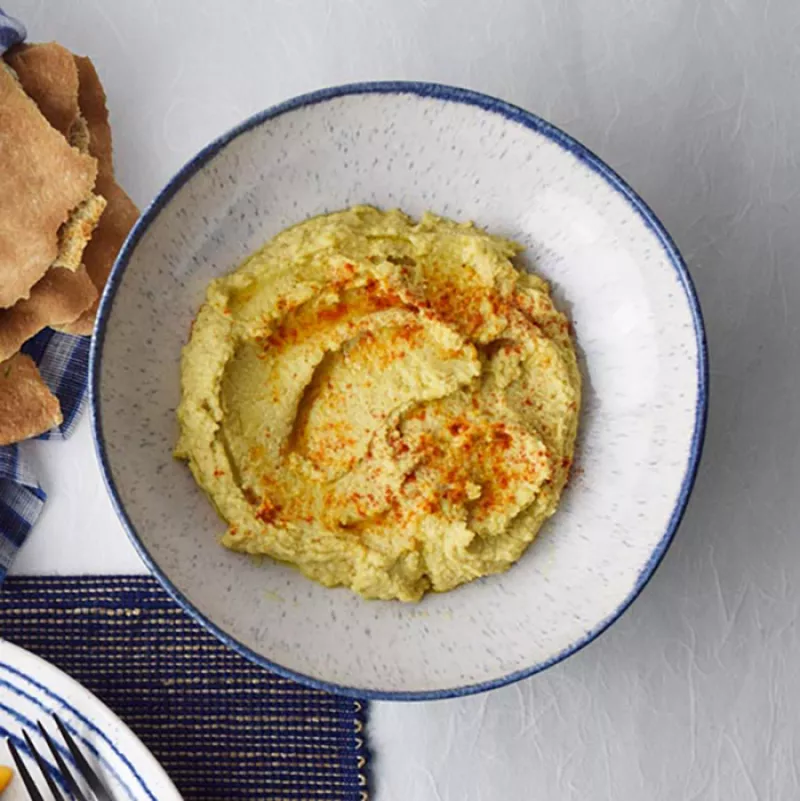Hummus is a healthy-snacking staple. That’s no surprise, with its base of chickpeas (garbanzo beans), tahini (sesame seed paste), and largely unsaturated oils (like sunflower, soybean, canola, or olive). You’re getting legumes, healthy fat, and (usually) not too much salt. Nice!
This article comes from Nutrition Action. We don’t accept any paid advertising or corporate or government donations. Any products we recommend have been vetted by our staff and are not advertisements by the manufacturers. They’re just healthy foods we think you’d like to know about!
Little Sesame: our new favorite spin on healthy hummus
Just about any brand of hummus is healthy, but sometimes you’re looking for a new spin. Enter Little Sesame, now sold nationwide in thousands of stores like Whole Foods, Sprouts Farmers Markets, Wegmans, and online.
True to its “little” name, the company started small with a restaurant serving up hummus-based bowls and pita sandwiches in Washington, DC, in 2018. When the pandemic hit, Little Sesame began packaging its hummus for grocery store shelves, where it debuted in 2021. Now, it’s sold coast to coast.
It’s hard to find a hummus that yields a creamier, smoother combo of chickpeas, tahini, sunflower and olive oils, garlic, lemon, and salt than Little Sesame’s Classic Hummus. And punchy flavors like Jammy Tomato, Caramelized Onion, Preserved Lemon, and Herby Jalapeño kick things up a notch. Mmm.
Bonus: Little Sesame dials up its flavor with no more sodium than a typical hummus—around 125 to 150 milligrams in each 2-tablespoon serving.
Learn more: Snacks that make healthy eating easy
More healthy hummus brands to try

Got time? To beat even the best-tasting supermarket hummus brands, make your own.
Kate Sherwood – CSPI.
Most varieties of hummus made by Sabra, Cedar’s, Tribe, and Ithaca (another brand that’s received high marks in our taste tests) are in the same ballpark as Little Sesame for calories, saturated fat, sodium, and other nutrients. So taste around and buy what you prefer…or what’s on sale! (Or make your own with this simple recipe from our Healthy Cook, Kate Sherwood.)
As for food additives, we found none of concern in any of those major brands. (Some varieties of Sabra and other hummus brands add the preservative potassium sorbate, which our Chemical Cuisine Food Additive Safety Ratings rate as “safe.”)
Little Sesame and Ithaca use “high pressure processing” (HPP), which applies high pressure instead of heat to prolong shelf life. Whether they use preservatives or HPP, most hummus brands say that they last for roughly a week in the refrigerator after you open them. Be sure to check your product’s label.
Ready to snack? For starters, use hummus as a dunker for raw veggies like carrot or jicama sticks, sliced cukes, bell pepper strips, mini tomatoes, or cauliflower florets. Or spread the dip on whole-grain crackers or pita bread. Just remember that the 70-or-so calories in every 2 (flat) tablespoons of hummus can add up quickly. So spread responsibly!
Learn more: 15 time-saving toppings to make flavors pop
How much protein and fiber are in hummus?

Hummus has only 2 grams of protein per 2 Tbs. serving, so add another protein like seasoned sliced tofu or tempeh to a vegetarian sandwich.
yuliiaholovchenko – stock.adobe.com.
While chickpeas and other beans and peas offer plant protein, hummus is part chickpeas and part healthy fat (tahini and oil), so a 2 Tbs. serving has just 1 to 2 grams each of fiber and protein. (A half-cup serving of chickpeas has about 6 grams of each.)
If hummus is simply a snacking go-to or side, that’s fine. But if you’re relying on it for a meal’s protein—say, a hefty dollop on a vegetarian salad or veggie-hummus sandwich—consider bumping up the protein. Add crispy roasted chickpeas to your salad or stuff a thin slab of store-bought pre-seasoned “baked” tofu into your veggie-hummus sandwich.
Learn more: Which foods have more or less protein than you thought?
